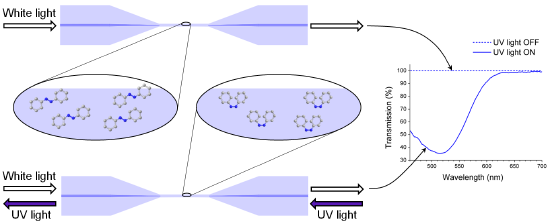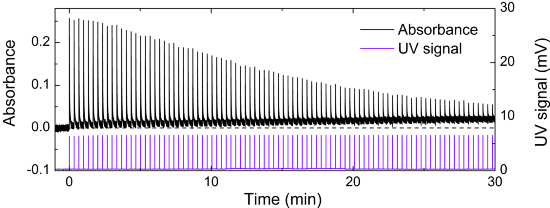Due to the tight confinement of light and, thus, the high intensity in the vicinity of the microfibre, the interaction between light propagating through the microfibre and the surrounding media is extremely strong. Therefore, molecules adsorbed on the surface of the microfibre can be detected with very high sensitivity via absorption and fluorescence spectroscopy [1, 2].
The strong evanescent field can be used not only to detect, but also to control organic molecules adsorbed on the microfibre. Photoswitchable molecules are a perfect candidate since they change their physical and chemical properties upon exposure to light. They feature two different forms and can be switched from one to the other form by using light of two different wavelengths. The scheme of switching these types of molecules is shown in Fig. 1.

Fig. 1. Switching a molecule between its isomers under exposure to light.
Azobenzene is used here to illustrate the concept.
This allows us to control the transmission properties of the microfibre by switching surface-adsorbed molecules from 'transparent' to 'coloured' form, see Fig. 2.

Fig. 2. Molecules in the transparent state do not absorb visible light (top microfibre). Upon exposure to UV light, the molecules are switched to the colored state, in which they absorb a significant part of the visible spectrum (bottom mircofibre).
Experiments with switching have already been made [3], where it has been shown that light of nanowatt power is sufficient to switch molecules between conformational states and at the same time can cause photodestruction, i.e., some molecules are destroyed by this light. This leads to a reduction of molecules that can be switched by UV light to the absorbing state (Fig. 3).

Fig. 3. Many subsequent switching cycles of the molecule spiroOH under UV light exposure. The decay of the absorbance peaks with the number of switching cycles reflects the effects of photodestruction, while the increasing baseline where the absorbance minima occur indicate that the destroyed molecules slightly absorb white light.
Additionally, we measured time-resolved photoswitching dynamics of molecules and found that we could control the switching speed by adjusting external factors such as the environment, deposition method, and the type of light pulses used. Since the switching process of diarylethene molecules themselves occurs on a picosecond timescale (in solution) [4], we expect the dynamics of adsorbed molecules to be governed by a similar time scale.
More information on our experiments on switching photochromic molecules can be found in the PhD thesis of Ulrich Wiedemann.
References- Warken et al. "Ultra-sensitive surface absorption spectroscopy using sub-wavelength diameter optical fibers", Opt. Express 15(19), 11952–11958 (2007)
- Stiebeiner et al. "Ultra-sensitive fluorescence spectroscopy of isolated surface-adsorbed molecules using an optical nanofiber", Opt. Express 17(24), 21704–21771 (2009)
- U. Wiedemann, W. Alt and D. Meschede, Switching photochromic molecules adsorbed on optical microfibres, Opt. Express 20, 12710-12720 (2012)
- M. Irie, “Diarylethenes for memories and switches,” Chem. Rev. 100, 1685–1716 (2000)
